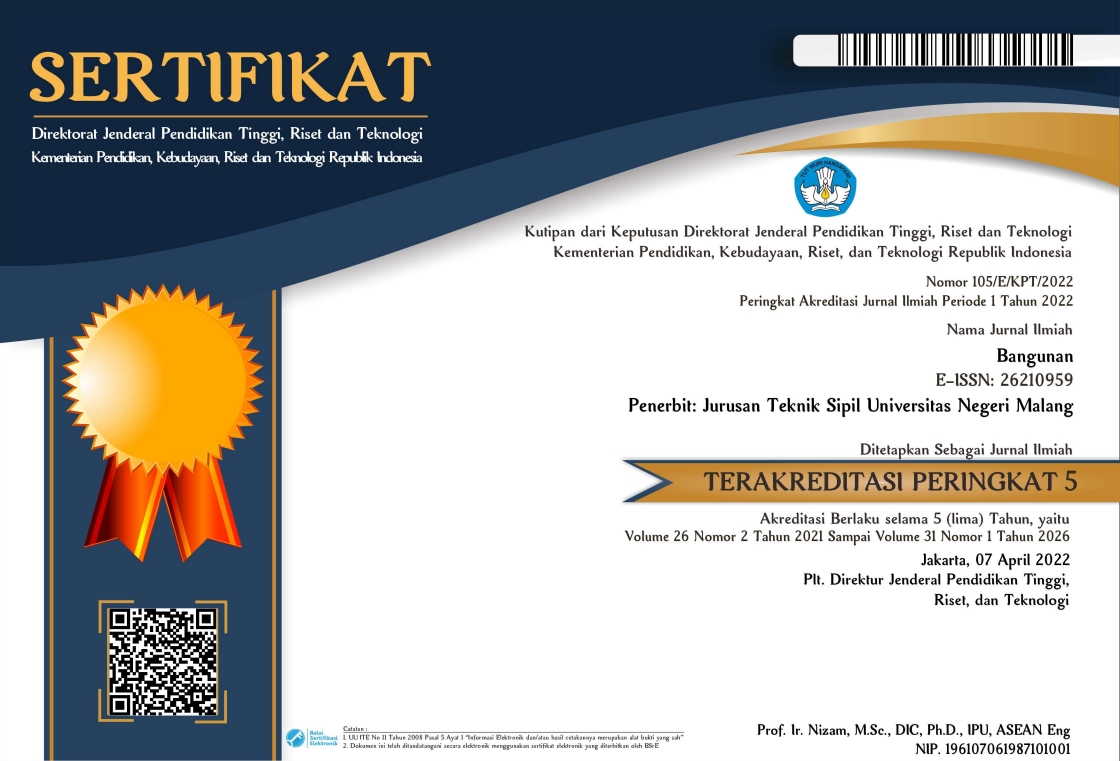ANALISA MODEL HIDROGRAF BANJIR KALI NGOTOK DENGAN METODE SCS, SNYDER DAN NAKAYASU
Abstract
Abstrak:Permasalahan banjir seringkali melanda wilayah DAS Kali Ngotok setiap tahun. Masalah banjir pada umumnya disebabkan oleh perubahan tata guna lahan dan penurunan fungsi sungai yang ada di wilayah DAS Kali Ngotok serta sering terjadinya back water dari sungai-sungai yang bermuara di Kali Brantas pada saat mengalami debit maksimal. Untuk itu studi perbandingan debit puncak banjir perlu dilakukan karena belum adanya penelitian mengenai pengendalian banjir. Sehingga dilakukan penelitian mengenai analisis model hidrograf satuan sintetik. Metode hidrograf satuan sintetik yang digunakan adalah SCS, Snyder, dan Nakayasu. Data hujan yang digunakan adalah data hujan tahun 1998-2016 dari 14 stasiun hujan di wilayah DAS Kali Ngotok. Metode poligon Thiessen digunakan untuk mengetahui besaran hujan yang tersebar di wilayah DAS Kali Ngotok. Besaran hujan rata-rata yang turun di DAS Kali Ngotok dalam kurun waktu 1998-2016 sebesar 97.05 mm. Pada tahap pemodelan, pembagian sub catchment DAS dilakukan dengan membagi menjadi 5 sub DAS. Hasil pemodelan dengan metode SCS, Snyder, dan Nakayasu menunjukkan besaran debit untuk kala ulang 2 tahun, 5 tahun, 10 tahun, 20 tahun, 25 tahun, 50 tahun, 100 tahun, dan 200 tahun yang bervariasi. Data AWLR yang mendekati hasil pemodelan adalah data tahun 2014. Hasil kalibrasi hidrograf untuk metode SCS dengan kala ulang 25 tahun sebesar 0.88, untuk metode Snyder dengan kala ulang 25 tahun sebesar 0.74, dan untuk metode Nakayasu dengan kala ulang 25 tahun sebesar 0.43. Dengan demikian model hidrograf SCS dengan kala ulang 25 tahun mendekati dengan model hidrograf lapangan berdasarkan data AWLR yang ada serta sesuai dengan hasil pengamatan pada saat survey penduduk.
Kata-kata kunci: DAS, Kali Ngotok, SCS, Snyder, Nakayasu
Abstract: Flood problems often hit the Ngotok River watershed every year. The problem of flooding is generally caused by changes in land use and a decrease in river functions in the Ngotok River watershed area as well as frequent back water from rivers which empties into Brantas River when experiencing maximum discharge. For that reason a comparative study of peak flood discharge needs to be done because there is no research on flood control. So that research is conducted on the analysis of synthetic unit hydrograph models. The synthetic unit hydrograph method used is SCS, Snyder, and Nakayasu. Rainfall data used is data from 1998-2016 from 14 rain stations in the Ngotok River watershed. The Thiessen polygon method is used to determine the amount of rain scattered in the Ngotok River watershed. The average rainfall in the Ngotok River watershed in the period 1998-2016 was 97.05 mm. In the modeling phase, the sub catchment division of the watershed is carried out by dividing it into 5 sub catchments. The modeling results using the SCS, Snyder, and Nakayasu methods show the amount of discharge for the return period of 2 years, 5 years, 10 years, 20 years, 25 years, 50 years, 100 years, and 200 years which varies. AWLR data approaching the modeling results are 2014 data. The hydrograph calibration results for the SCS method with a 25 year return period are 0.88, for the Snyder method with a 25 year return period of 0.74, and for the Nakayasu method with a 25 year return period of 0.43. Thus the SCS hydrograph model with a 25 year return period approaches the field hydrograph model based on the AWLR data that exists and is in accordance with the observations during the population survey.
Keywords: Watershed, Ngotok River, SCS, Snyder, Nakayasu
Full Text:
PDFDOI: http://dx.doi.org/10.17977/um071v25i22020p1-10
Refbacks
- There are currently no refbacks.

This work is licensed under a Creative Commons Attribution-ShareAlike 4.0 International License.



